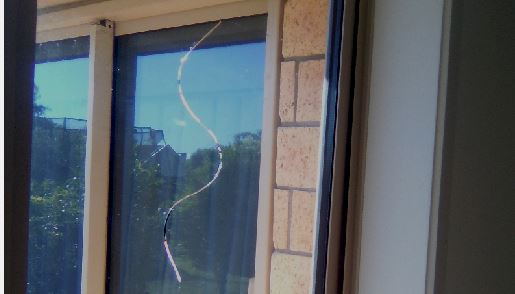On Christmas Eve, child number 1 spotted a crack in a window. It’s a double-glazed window, and inspection showed that the small, horizontal crack was in the outermost pane. It was perpendicular to the frame, about three-quarters of the way up one side. The origins are a mystery. It MIGHT have something to do with repeated encounters with footballs, tennis balls (usually flying off the face of a cricket bat), rugby balls, frisbees and the like. Or it might be a thermal stress – this window gets full sun in the early morning.
Over the next few days, this crack grew, in quite an interesting way. It always grew at night. We never saw any discernable growth in it during daytime, but each morning of the next few days the crack was longer than it had been the night before. And it made an astonishingly neat ‘wave’ pattern, as you’ll see in the photo.

What is happening here?
First, it’s worth noting that modern double-glazed windows are extremely hard to break. The glass is toughened and the two panes together are able to absorb considerable energy. For example, don’t rely on being able to smash your way through one in the event of a fire, for example. The video here will show you just what an effort it is! If you have to break through one, hit it hard near a bottom corner with something heavy and pointed.
Second, cracks act to concentrate stresses at the crack’s point (where it ceases from being a crack) which is why cracks, be they in pottery or rocks or paper (think ‘tearing’ a sheet of paper) tend to grow very easily. Once you get them started, they can often continue easily. Thus there’s no surprise that the original crack, a few centimetres in length, has now extended itself down to the lower edge of the window.
But why the lovely wave pattern? Here I’m speculating a bit. Oscillatory behaviour suggests a restoring force of some kind towards a central point. That is to say, when you are one side of the centre, you are pushed back towards the centre. In the special case where we have a restoring force that is proportional to the distance from the equilibrium point, we get simple harmonic motion – examples include an object bouncing up and down on the end of a spring, or a swinging pendulum. So perhaps when the crack moves towards an edge of the window, the stresses caused by the frame somehow result in a ‘force’ pushing the crack away from the edge and back towards the centre. It then heads that way, carries on past the centre, and towards the other edge whereupon a similar thing happens – it gets ‘pushed’ back to the centre again. Whatever the reason, the effect was pretty impressive.
And why did it only grow at night? More speculation here, but this might be down to thermal stress. The outer pane of glass would drop in temperature during the night, but then the early morning sun would hit it and start raising its temperature quickly. But the sun wouldn’t hit all the window at once. The shape of the house means that one side (the left as you look at the photo) would get the sun before the other side, which would remain shaded. So we’d have at about 6 am (before anyone gets up) half the window facing the rising sun and heating rapidly, and half the window still in the shade of night. The thermal stress set up could be considerable here.
Now Christmas holidays are over, we can get the glass replaced.
